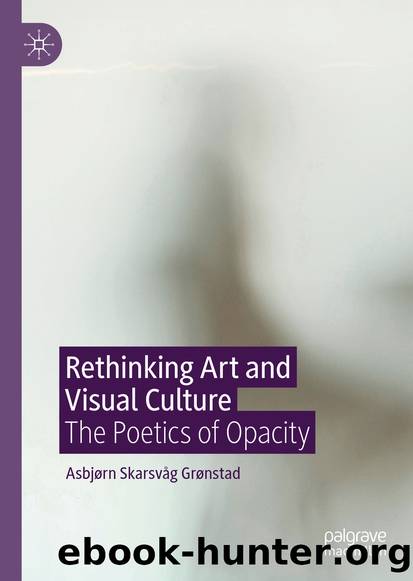Rethinking Art and Visual Culture by Asbjørn Skarsvåg Grønstad

Author:Asbjørn Skarsvåg Grønstad
Language: eng
Format: epub
ISBN: 9783030461768
Publisher: Springer International Publishing
In the picture that is being painted here, participation in hermeneutic practices is seen as the adversary of an ideal of transparency defined in terms of a reductive techno-administrative rationality. Politics, because it presupposes meaning and knowledge, requires engagement with hermeneutic activities like reading and interpretation. The poetic approach that Chamoiseau promotes is therefore more enmeshed in the political than we think it is. For this reason, questioning the worthwhileness of reading could be injurious to the health of political processes. But, as Simek is quick to address, if the poetic approach that opacity facilitates is to have a political effect, the specific forms it takes matters.46 In short, opacity needs to be made operational through suitable aesthetic approaches. An insistence on absolute unknowability and irreducibility is quite forbidding and may inhibit both the possibility of and desire for hermeneutic commitment. One ought to keep in mind that opacity is not the obverse of transparency; it is not the nothing to transparencyâs something, but it is a negation of transparency in an absolutist sense. That an image is opaque does not mean that it does not have a content, that it resists interpretation, or that we cannot make sense of it. But it does mean that it possesses what Simek calls âa stubborn density,â a recalcitrant texture that necessitates further analysis and contemplation.47
If we are to comprehend the rarely disputed sovereignty of the transparent, of optimal clarity, we could go back to Enlightenment thinkers like Jean-Jacques Rousseau and Jeremy Bentham, who linked transparency to the management of representative government. Visibility ensures that the few who govern are held accountable to those governed by them. Closely aligned with the notion of rational thought, transparency in this tradition was practically methodological in nature, as it instituted a condition of possibility for a praxis of governance based on rules and regulations that were predictable and reproducible. The function of transparency in bolstering democratic structures lent it a lasting moral credibility, yet what complicates the presumed preeminence of transparency in an historical as much as a contemporary perspective is its complicity with a politics of surveillance. As we recall, this attribute of transparency is what troubles Jonathan Crary when he discusses the terror of a âworld without shadows.â As Simek puts it, âstate actors throughout the eighteenth and nineteenth centuries also sought to âmake the many visible to the few,â to control and shape the behavior of large masses of people through various surveillance techniques and practices of knowing, often in the name of rational thought and enlightened progress.â48 The naturalization of transparency as self-evidently moral and secrecy as inherently objectionable has been confronted and critiqued by among others Clare Birchall, who recommends that we rethink and disconnect these entrenched associations.49
For Glissant , opacity is no less than a project of resistance, a set of strategies that may be mobilized in specific socio-political situations. I have in a previous chapter provided an account of Glissantâs positionâin particular with reference to Levinasâs take on alterityâbut
Download
This site does not store any files on its server. We only index and link to content provided by other sites. Please contact the content providers to delete copyright contents if any and email us, we'll remove relevant links or contents immediately.
The Japanese by Christopher Harding(1086)
Watercolor With Me in the Forest by Dana Fox(753)
A Theory of Narrative Drawing by Simon Grennan(742)
The Story of the Scrolls by The Story of the Scrolls; the M(725)
Glittering Images: A Journey Through Art From Egypt to Star Wars by Camille Paglia(718)
Boris Johnson by Tom Bower(620)
This Is Modern Art by Kevin Coval(599)
The Art and Science of Drawing by Brent Eviston(591)
Frida Kahlo by Frida Kahlo & Hayden Herrera(586)
AP Art History by John B. Nici(575)
Banksy by Will Ellsworth-Jones(570)
War Paint by Woodhead Lindy(551)
Van Gogh by Gregory White Smith(547)
Draw More Furries by Jared Hodges(546)
Scenes From a Revolution by Mark Harris(544)
About Looking by John Berger(543)
Ecstasy by Eisner.;(535)
100 Greatest Country Artists by Hal Leonard Corp(524)
Young Rembrandt: A Biography by Onno Blom(514)
